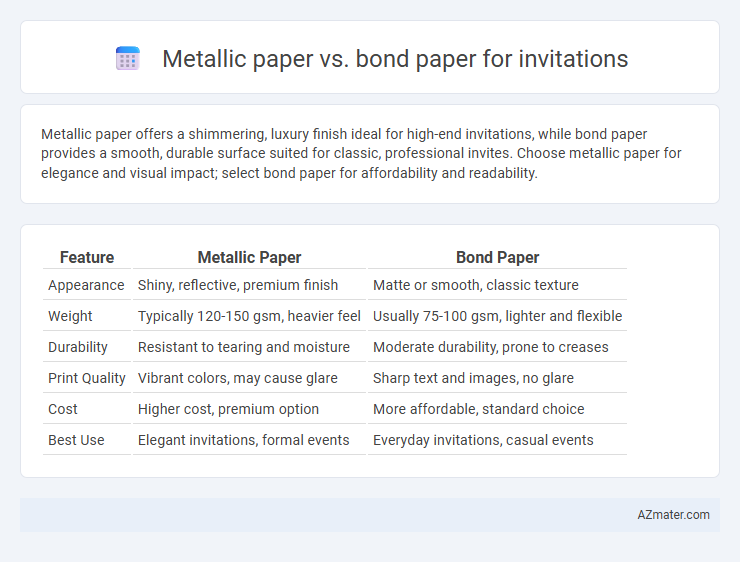Metallic paper offers a shimmering, luxury finish ideal for high-end invitations, while bond paper provides a smooth, durable surface suited for classic, professional invites. Choose metallic paper for elegance and visual impact; select bond paper for affordability and readability.
Table of Comparison
| Feature | Metallic Paper | Bond Paper |
|---|---|---|
| Appearance | Shiny, reflective, premium finish | Matte or smooth, classic texture |
| Weight | Typically 120-150 gsm, heavier feel | Usually 75-100 gsm, lighter and flexible |
| Durability | Resistant to tearing and moisture | Moderate durability, prone to creases |
| Print Quality | Vibrant colors, may cause glare | Sharp text and images, no glare |
| Cost | Higher cost, premium option | More affordable, standard choice |
| Best Use | Elegant invitations, formal events | Everyday invitations, casual events |
Introduction to Invitation Paper Types
Metallic paper features a shimmering, reflective surface ideal for creating luxurious and eye-catching invitations, while bond paper offers a smooth, matte finish preferred for classic and professional designs. Metallic papers are typically heavier and more durable, enhancing the tactile experience of formal events like weddings or galas. Bond paper is cost-effective and versatile, making it a popular choice for everyday invitations that require crisp text and images.
What is Metallic Paper?
Metallic paper is a premium printing substrate known for its shimmering, reflective surface achieved through a special coating that mimics the look of metal. This paper enhances invitation designs by adding a luxurious, eye-catching shine that makes colors pop and images appear more vibrant. Often chosen for upscale events, metallic paper stands out compared to traditional bond paper, which lacks this glossy, textured finish.
What is Bond Paper?
Bond paper is a high-quality, durable writing paper commonly used for official documents, letters, and invitations due to its smooth texture and strong fibers. Unlike metallic paper, which has a reflective, glossy finish, bond paper offers a matte surface that enhances readability and provides a classic, professional appearance. Its excellent ink absorption makes bond paper ideal for detailed printing, ensuring invitations look crisp and elegant.
Appearance and Visual Appeal Comparison
Metallic paper offers a luxurious, reflective sheen that enhances invitation design with vibrant colors and shimmering effects, creating a striking, premium appearance. Bond paper provides a smooth, matte finish that delivers a classic and clean look, ideal for elegant simplicity and readability. For invitations, metallic paper captures attention with its dazzling visual appeal, while bond paper emphasizes understated sophistication.
Texture and Handling Experience
Metallic paper offers a glossy, reflective surface that enhances the visual appeal of invitations with a smooth, almost slick texture, making it ideal for formal events seeking a luxurious feel. Bond paper, known for its matte finish and fibrous texture, provides a more traditional and tactile experience, offering ease of handling without the risk of fingerprints or smudges. The choice between metallic and bond paper impacts not only the invitation's aesthetic but also the tactile interaction, with metallic paper often requiring more careful handling due to its delicate coating.
Print Quality and Color Reproduction
Metallic paper offers a vibrant and reflective surface that enhances print quality with a dazzling finish, ideal for invitations requiring eye-catching brilliance. Bond paper provides a smooth, matte texture that delivers sharp, precise text and true-to-life color reproduction, ensuring elegant and professional results. Choosing between them depends on whether the priority is striking visual impact or classic clarity in printed invitations.
Suitability for Various Invitation Styles
Metallic paper offers a shimmering finish ideal for formal or glamorous invitations like weddings and galas, enhancing elegance with its reflective surface. Bond paper provides a smooth, matte texture suited for classic, minimalist, or business events, delivering a professional and clean appearance. Choosing between metallic and bond paper depends on the desired tone and style of the invitation, with metallic enhancing luxury and bond supporting simplicity and versatility.
Durability and Practical Considerations
Metallic paper offers high durability with its moisture-resistant and tear-resistant properties, making it ideal for invitations that require a premium, long-lasting finish. Bond paper, while less durable, provides a practical and cost-effective option with good ink absorption and easy writeability for mass production. Choosing between metallic and bond paper depends on the balance between durability needs and budget constraints for event invitations.
Cost Differences Between Metallic and Bond Paper
Metallic paper typically costs significantly more than bond paper due to its specialized finish and premium materials, making it a higher-priced option for invitations. Bond paper, commonly made from cotton or wood pulp, offers a more economical choice while maintaining quality and durability for printing. When budgeting for invitation printing, considering the cost difference is crucial as metallic paper can increase overall expenses by 30-50% compared to standard bond paper.
Choosing the Best Paper for Your Invitations
Metallic paper offers a glossy, shimmering finish that enhances the elegance of wedding or event invitations, making them stand out with a luxurious feel. Bond paper provides a smooth, sturdy texture ideal for formal and professional invitations, ensuring durability and easy readability. Choose metallic paper for a glamorous visual impact, while bond paper suits traditional or minimalist designs where clarity and substance are paramount.

Infographic: Metallic paper vs Bond paper for Invitation
 azmater.com
azmater.com